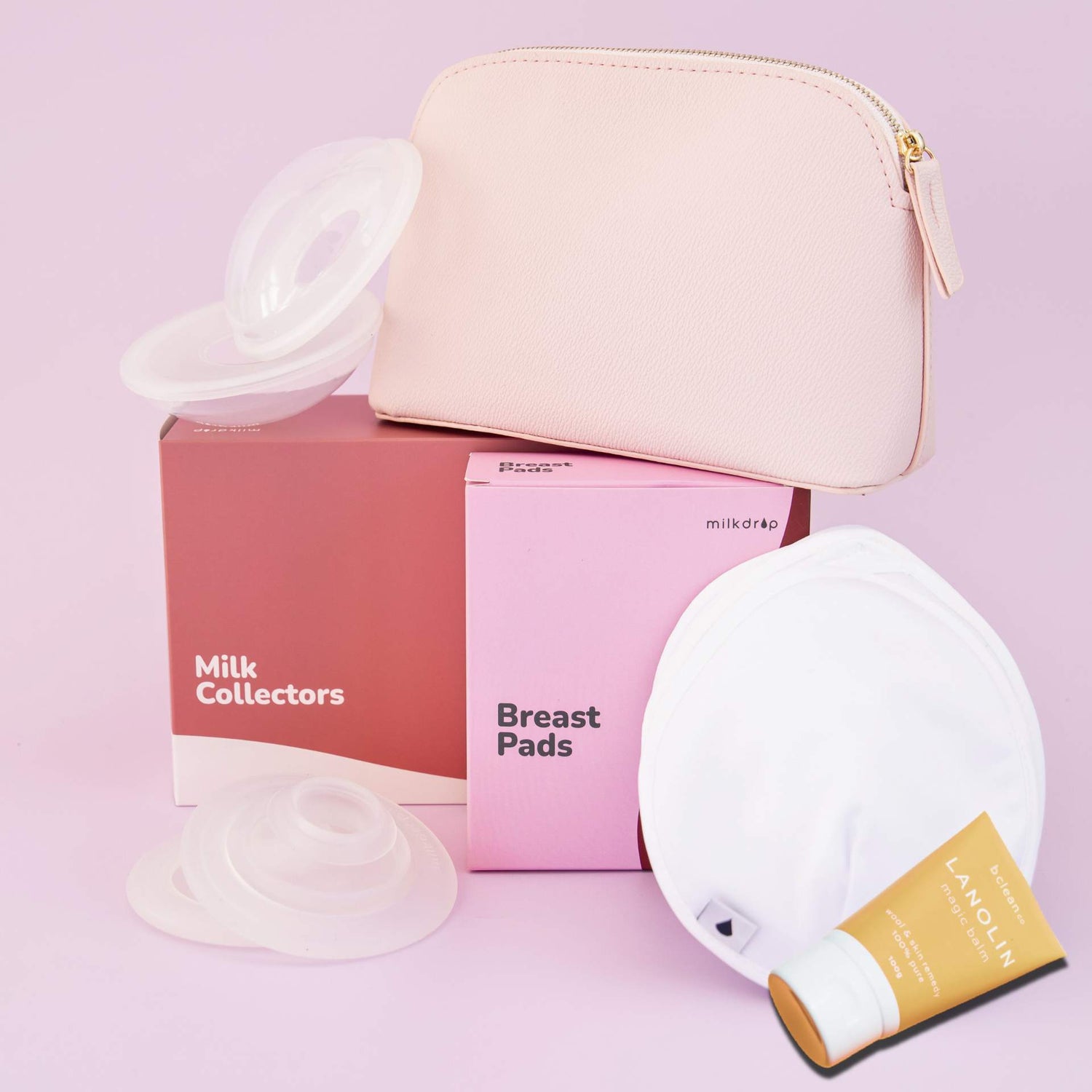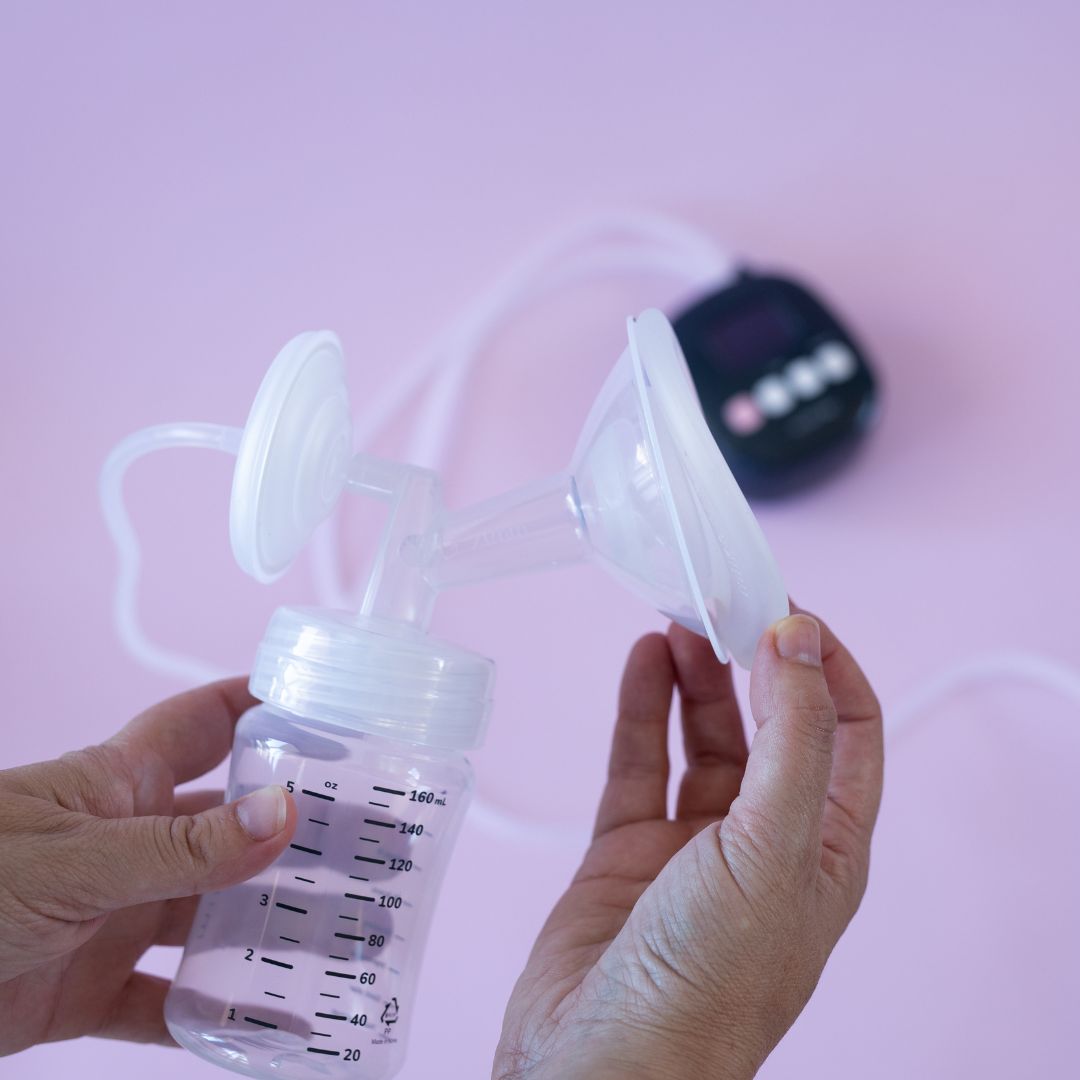Getting the right flange size can make a big difference to your comfort and milk flow, but it can be confusing figuring out which flange size is 'right'. In this post, we'll share everything there is to know about getting the best fitting flange for your body.
The short answer
👍 Getting the ‘right’ flange size can make a big difference to your comfort and milk flow.
📏 Start by measuring your nipple with a ruler, or our handy ‘nipple-sizer’ printout (get it via the form below!)
👩⚕️ Ask your lactation consultant for help, especially if you’re having pain or discomfort.
⏭️ Skip this article, and take the sizing quiz to find the right Milkdrop pump and cushion size for you.
What we'll cover:
- Flange Basics
- Finding the right flange size
- How do I measure my nipple to get the right flange size
- Why flange size isn't the only thing that impacts comfort
Want to read it later (maybe while you're pumping)? Get your Pocket Guide to Flange Sizing here 👇🏽
1. The Basics: What's a flange?
A flange is the cone-shaped part of your breast pump that fits to your breast.
> What is flange size?
When people talk about “flange size”, they are referring to the diameter of the tunnel that your nipple is sucked into.

> Is there a standard flange size?
Breast pumps tend to have a range of flange sizes from about 20 millimetres to 36 millimetres.
When you buy your pump, you'll get their standard size flange (if you don't specifically order a different flange size).
This is usually about 24/25mm. Some pump brands come with two standard sizes.
Milkdrop pumps come in four sizes (XS - 15mm, S - 20mm, M - 25mm, L - 30mm) and also with cushions that mold to your shape.
Here’s a table of all the flange sizes that are available for pump brands.

Please let us know if you can’t see your pump, or we’ve got it wrong, and we’ll get onto that ASAP.
2. Finding the right flange size
Having the wrong flange size is one of the most common (although not the only) reason for pain, discomfort and damage when pumping. Getting the right size flange for you will mean you have the best possible comfort, seal and milk flow.
If your pump flange size is too big, you can pull your areola unnecessarily into the pump funnel and damage the skin and tissue. We know from this study, and this study, that about 15-17% of women who use breast pumps have nipple injury and damage.
If your pump flange size is too small, you can rub your nipple against the plastic or block milk duct openings.

👆🏼 This flange is too large. See how the areola is sucked in with the nipple and swells.

👆🏼 This flange is too small. See how the nipple rubs on the side of the tunnel, and can’t really move much.

👆🏼 This flange looks about right. See how the nipple extends within the tunnel, but the areola says mostly where it is.
> Why might I need a different flange from the one that comes with my pump?
Despite the many different shapes and sizes of nipples, the only thing you can change with most breast pumps is the diameter of the tunnel that your nipple is sucked into.
Pumps don’t really take into account your nipple shape (inverted, flatter, rounder, longer), or how your nipple responds to the pump suction – whether it is elastic (stretches a lot) or fibrous (doesn’t stretch much). We made Milkdrop pumps and cushions for this reason, but more on that later.
> How do I know if my flange size is too small?
Some signs that might indicate that your flange is too small are:
- your nipple doesn’t move easily in the tunnel of the flange
- you have indents on the top or close to the side of the nipple
- you have pain or rubbing of the nipple (not areola)
- you feel like your ducts are blocked by the flange
- it takes you ages to get milk flowing
- your breasts still feel full after expressing
How do I know if my flange size is too large?
Some signs that might indicate that your flange is too large are:
- your areola (the part around your nipple) is drawn into the flange
- you have swelling and soreness of your areola and the base of your nipple when you take the pump off
- you have chafed skin in a ring around your areola
- you don’t have good suction - the pump falls off, loses contact with your breast when its on, or it makes suction-y squelchy noises
- you have milk leaking from the pump between your breast and the flange
- it takes you ages to get milk flowing
- your breasts still feel full after expressing
> How will I know if I have a proper flange fit?
When you have the right size flange for you, you should be able to check-off this list.
So, your nipple should move freely, without touching the sides. Your areola should move a tiny bit, but not be sucked into the tunnel with your nipple. You may feel tugging but not pain or discomfort. When you remove your breast after a session, your nipple might be extended but your areola shouldn't be bloated and sore. You should have a good seal, which means you won't have air around your nipple or hear any suction-y noises 🤭. You should get good milk flow (squirts or faster droplets of milk), and after pumping for a session, you should feel that you've drained as much milk as you can.
If you find yourself needing icepacks, or heatpacks when you’re finished, then check your flange size, and seek help from your lactation consultant or doctor.
3. How do I choose the right flange size for my nipple?
To choose the right flange size, you'll need to measure your nipple diameter and choose the closest flange available for your pump.
> How do I measure my nipple?
If you have access to a few different flange sizes (perhaps your friendly lactation consultant or some friends who pump can help you here), then you can go by feel. Just try on different flanges, and work through the flange-fit checklist above.
If you don't have access to different flange sizes, you'll need to measure your nipple.
As an overview, you will need to:
- Get a measuring tape or ruler.
- Look at your nipple to work out what to measure - you'll need to measure only your nipple, not your areola.
- Stimulate your nipple (don't measure after you've pumped as your nipple might be swollen).
- Measure your nipple (check out the diagrams below).
- Check your nipple measurement against our handy chart below to work out the best flange for your nipple.
- Test, tweak and experiment!
Now for the details:
>> Step 1. Grab a ruler, measuring tape or download our nipple measuring tool.
It'll need to have millimetres.
👆🏼 If you use this nipple ruler, you need to print at 100% (make sure your printer isn’t scaling the document in the settings) and cut out the semi-circles with scissors.
>> Step 2. Look at your nipple (we’re not kidding)
You need to figure out what you’re measuring exactly, before you start.
You want to measure the distance from one side of your nipple to the other. Your nipple is the pointy or bumpier part in the middle. Your areola is the wider circle or darker skin around it👇🏽

To measure, you will start from one side of your nipple where it meets the areola, and measure across to the other side. Take care not to measure the areola, because you’ll end up measuring too big.
👇🏽 Here’s what that might look like on your nipple.


>> Step 3. Prepare your nipple.
Some advice recommends that you measure after pumping, but that can be problematic for two reasons:
- You have to have a pump handy, and be ready to use it (i.e. lactating right now)
- If you’re pumping on a flange that’s too large already, your nipple will likely swell to the size of the flange and be bloated. This would mean that you’d measure too large.
We suggest that rather than pumping, just stimulate your nipple. You can do this by pulling on your nipple gently with your fingers, which will raise it or plump it up a bit.
>> Step 4. Measure your nipple
Measuring is often best done in front of a mirror, or with the help of your partner or carer.


>> Step 5. Do some math
Now you have your diameter, add 1-2mm and choose the closest flange size available from your pump brand. Use the table above, or google your pump for flange sizes.
If you measure on the smaller end. For example, if you measure 12mm, you can see that for most brands, then the closest size for you is….21mm.
Thankfully, the following companies make inserts or separate flanges that you can attach or insert in your pump that better match your size.

If you're only smaller by a couple of millimetres, you can also use a Milkdrop cushion which will help make a slightly larger flange fit more comfortably.
>> Step 6. Test and change it up
As with most things pumping, you may need to try out your new size, run through the flange-fit checklist, and then change if you need.
Also remember that the flange size you choose is just a starting point. You may need to change it up as you get used to pumping or as your breast changes over time.
> My flange size is slightly too big. Do I need to buy a new one?
You can, but if you're looking to slightly narrow your flange and get a more comfortable pump, you can try a Milkdrop cushion. A Milkdrop will last just as long as your flange - and you can return it if it doesn't feel quite right.
4. Why flange size isn't everything.
Flange size is super important to getting a more comfortable pump, but it's not the only thing impacting your pumping experience.
Even if you have the right flange size, you're still pushing your nipple and areola up against a hard surface, which can cause swelling, chafing, discomfort and damage. Milkdrop cushions are 10x softer than your pump and move with your nipple to provide a much gentler pumping experience.
The help from a pump-savvy lactation consultant can be pure gold. Even if your flange is fitting correctly, there will be things they can help with about how and when to use your pump, when NOT to use your pump, and other lactation related things that can make a huge difference to your experience. Send us an email at support@milkdroppumps.com if you'd like any lactation consultant recommendations.
Want more info?
Whoo! You've made it to the end of this very long post. If you still want more, we've written a whole lot more about finding your perfect flange size, because it's so important for a comfy pump! Check out:
- 3 mistakes you're probably making when figuring out your flange size
- 7 common questions about flange sizing
Learn more about Milkdrop
We are a small group of designers who started redesigning pumps four years ago after experiencing painful pumping ourselves. We have been researching nipple size, shape, elasticity for those four years, and have designed and developed breast pump cushions and pumps to try to fit the full variation and uniqueness of womens' bodies. From our research, we know that 20% of people have nipple pain or damage using pumps, and we're on a mission to improve that by personalising how the pumps fit.
Check out our pumps here. And our cushions here.





